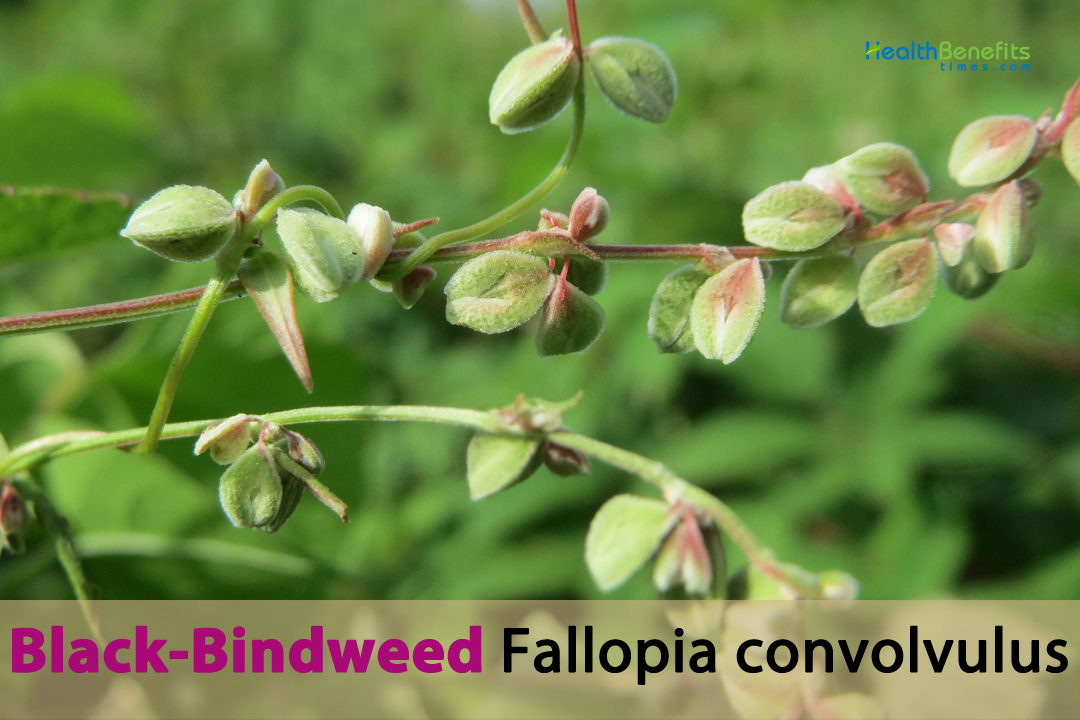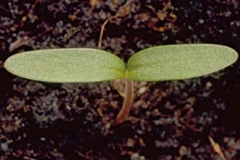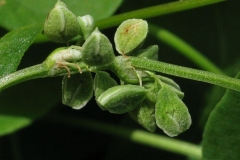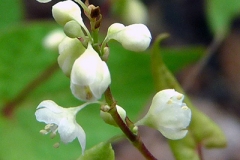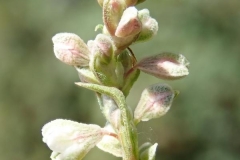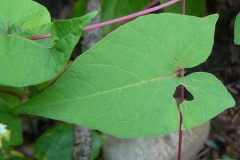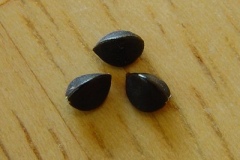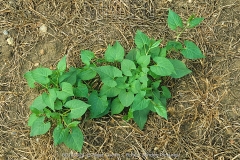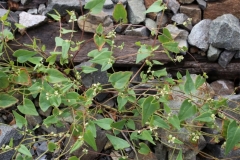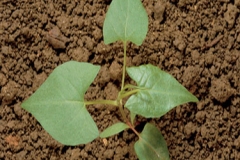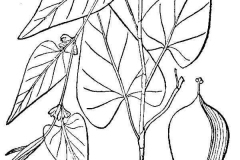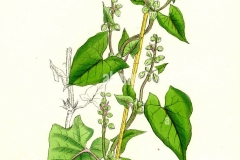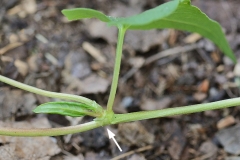The genus name “Fallopia” is derived from Gabriele Fallopio (1523-1575), an Italian anatomist. Fallopio was well-known for his contributions to anatomy and meticulous investigations of human reproductive organs. In his honor, the genus name was created. The genus name “convolvulus” is derived from the Latin verb “convolvere,” which means “to twine” or “to coil.” It refers to a plant’s climbing or twining habit, in which the stems coil around other plants or structures for support. The plant can be a weed in most crops, but cereals are where it causes the most difficulty. In addition to potatoes, sugar beets, and vegetables, as well as vineyards and plantations, it may cause yield losses. It is a weed of 25 commodities in 41 countries, and in 20 of these crops, it is considered a severe weed.
Black Bindweed Facts
| Black-Bindweed Quick Facts | |
|---|---|
| Name: | Black-Bindweed |
| Scientific Name: | Fallopia convolvulus |
| Origin | Throughout Europe, Asia and northern Africa |
| Shapes | Triangular achenes with obtuse bases and pointed tops |
| Taste | Mild and slightly bitter |
| Health benefits | Digestive health, Wound healing, Cardiovascular health, Weight management, Skin health, Liver support, Blood sugar control, Respiratory support, Eye health, Bone health, Stress management, Immune system support |
| Name | Black-Bindweed |
|---|---|
| Scientific Name | Fallopia convolvulus |
| Native | Throughout Europe, Asia and northern Africa |
| Common Names | Black-bindweed, Wild buckwheat, Climbing buckwheat, Corn-bind, Climbing knotweed, Smaller bindweed, Black weed, False black-bindweed, Small-leaved bindweed, Tangle head Cornweed, Creeping buckwheat, Cornfield bindweed, Lesser bindweed, Small-flowered bindweed, Black-grained bindweed, Black-grain, Devil’s tail, False buckwheat, Hedge bindweed, Swamp smartweed, Black sheepweed, Wild morning glory |
| Name in Other Languages | Afrikaans: Swart-winde, Slinger-duisendknoop, Wilde bokwiet Albanian: Vreshtadhe e zezë, Vreshtadhe e egër, Lulja e hudhresë, Lisi i zezë, Eger vreshtadhe, Luleshqip, Bari i shenjte, Vreshtat e zi, Lulja e zeze, Lulja e ngushte, Lulëzi i zi, Lulëzi i egër, bilderdikie, bilderdykia dredhje Arabic: Aqdah al-sharayan (عقدة الشريان) Argentina: Enredadera Belarusian: Drason voyny (Драсён павойны) Bengali: Kalo bel (কালো বেল) Brazil: Cipo-de-veado-de-inverno Bulgarian: (Cherna lazorot (Черна лазорот), Cheren bindvid (Черен биндвид), Cherna bindvida (Черна биндвида), Cherna palzyashta binda (Черна пълзяща бинда), Cherna krepostna trikratka (Черна крепостна трикратка), Cherno klechko (Черно клечко), Pŭlzyashta klechka (Пълзяща клечка), Cherna pŭdarka (Черна пъдарка), Cherno grozde (Черно грозде), poveticovidno piperiče (поветицовидно пиперче) Catalan: Fajol bord Chile: Enredadera Chinese: Liè yè liǎo (裂叶蓼), Liè yè fān bái cǎo (裂叶翻白草), Liè yè shān liǎo (裂叶山蓼), Hei man cao (黑蔓草), Hēi yóu gāncǎo (黑油甘草), Liè yè fēibái cǎo (裂叶飞白草),wan shou wu, Juǎn jīng liǎo (卷茎蓼),mán shǒu wū(蔓首乌) Chuvash: Суя йытпырши Croatian: Crna vlasulja, Crna bršljanovka, Crna slazolika, Crna puzavica, Obična puzavica, Crna zvončica, Crna livadna krvava, Crna gušterica, Crna potkovica, Crna ivančica, Crna leska, Crna ljeska, povijajuća heljda Czech: Vřesoviště prutnaté, Lichořeřišnice prutnatá, Přeskakuje, Prostírání, Prostíračka pnoucí, Opletka obecná, pohanka svlačcovitá Danish: Klokke-herredåbe, Klatre-herredåbe, Sort bundbønne, Sorte bjergvin, Vejstjerne, Bjergvinde, Vejreb, Vejsnerre, Klokkerebe, Almindelig klokke, Snerle-pileurt Dutch: Klimwinde, Smalle duivekervel, Klimkamperfoelie, Zwarte haagwinde, Kleine duivekervel, Echte kamperfoelie, Echte haagwinde, Zwaluwtong, wilde boekweit English: Black Bindweed, Climbing-Buckwheat, Cornbind, Wild Buckwheat, Eurasian Black Bindweed, Climbing Buckwheat, Corn Bindweed, Dullseed Cornbind, Wild False Buckwheat, bearbind, bearbine, black knotweed Estonian: Aed-päideroog, Must päideroog, Mets-päideroog, Must keerdhein, Päideroog, Metsik kampkress, Must kasteleht, Lohiserv, Must lehtkress, põld-konnatatar Finnish: Kierteishanhikki, Mustalainen, Mustahanhikki, Kiertokurkka, Kierteishampunlehto, Kiertomutka, Kierrelma, Mustapetkele, Kiertyö, Lankavintiö, Liuskakierre, Kiertotatar French: Renouée liseron, Renouée liseron à petites fleurs, Faux-liseron, Liseron convolvulus, Petite renouée, Renouée des champs, Renouée des haies, Liseron des champs, Liseron volubile, Liseron à vrilles, Renouée faux-liseron, Renouée liseron, Chevrier, faux liseron, renouée liseron, vrillée sauvage, fallopia liseron, vrillée faux-liseron Georgian: Q’anis ch’leki (ყანის ჭლექი) German: Kletten-Knöterich, Kletterknöterich, Kleiner Knöterich, Schwarzer Windenknöterich, Kleinknotiger Windenknöterich, Feld-Knöterich, Echter Knöterich, Echter Wiesenknöterich, Gemeiner Knöterich, Acker-Knöterich, Acker-Flügelknöterich, Gewöhnlicher Windenknöterich, gemeiner Windenknöterich Greek: Fallopia (Φαλλοπία), Skorpídi (Σκορπίδι), Mavropinakas (Μαυροπίνακας), Mavrochortostroviloplanos (Μαυροχορτοστροβιλοπλανος), Mavrostróvilos (Μαυροστρόβιλος), Mávri achladósporos (Μαύρη αχλαδόσπορος), Mávri klimákia (Μαύρη κλιμάκια), Fallópina (Φαλλόπινα), Skórpina (Σκόρπινα), Mavrólio (Μαυρόλιο), Skorpínas (Σκορπίνας), Mávri violítsa (Μαύρη βιολίτσα), anarrichómeno polígono (αναρριχώμενο πολίγωνο) Hebrew: Kantrit shahora (קנטרית שחורה), Falopia Havalbalit, פלופיה חבלבלית, aloppeyah chavalballit, flupih khblblis (פָלוֹפְּיָה חֲבַלְבַּלִּית) Hindi: Kali lata (काली लता) Hungarian: Réti lórom, Feketelórom, Vadszőlő lórom, Fekete csörgő, Lóromfajzat, Szőlőfajzat, Fekete csavargó, Fekete ördögszőlő, Fekete ördögszárny, Tengerészpálma, szulák keserűfű, ugari szulákpohánka Icelandic: Vafsúra Indonesian: Labu liar hitam Iran: Pichak band Irish: Glúineach dhubh Italian: Fallopia convolvolo, Convolvolo selvatico, Fallopia campana, Bindweed nero, Persicaria convolvolo, Lenticchia nera, Fallopia convolvolo comune, Persicaria selvatica, Convolvolo comune, Spremuta nera, Poligono convolvolo, erba leprina, convolvolo nero, erba leprina Japanese: Tsurufuderi (ツルフデリ), Konashtsurufuderi (コナシツルフデリ), Tsurufuderiazami (ツルフデリアザミ), Burakku baindouīdo (ブラックバインドウィード), Kyoukonkazura (キョウコンカズラ), Karasubaindou~īdo (カラスバインドウィード), Utsubogusa (ウツボグサ), Hekusokazura (ヘクソカズラ), Sekkotsukazura (セッコツカズラ), soba-kazura (ソバカズラ) Kashubian: Pòwijôczowatô dërdestówka Korean: Budeulsung-ipul (부들숭이풀), Budeulpul (부들풀), Budeul rabeondeo (부들 라벤더), Beullaekbaindeuwideu (블랙바인드위드), gud-eun sontob pul (굳은 손톱 풀), geom-eun labendeo (검은 라벤더), geom-eun baindeuwideu (검은 바인드위드), geom-eun budeul (검은 부들), geom-eun ping-geoluteu (검은 핑거루트), geom-eun somangpul (검은 소망풀), na do talk ui deong gul (나도닭의덩굴) Latvian: Riekstu migla, Melnā migla, Meža šķērātājs, Melnais tarakans, Mākoņābols, Melnā miglena, Miglas kraukšķis, Melnais rieksts, Dārza vējgriķis Lithuanian: Riškuotasis primenamasis, Riškuočių išrieškotas, Juodas riešutmedis, Kupolus primenamasis, Kūločių rūkelė, Plonasis daublėsžiedis, Gilinio riešutmedis, Rūkščių riešutmedis, Kūločių medis, Vijoklinis pelėvirkštis Malayalam: Karutha mootha koova (കറുത്ത മൂത്ത കൂവ) Northern Sami: Njoammodáđir Morocco: Faux liseron Netherlands: Wilde boekweit, zwaluwtong Norwegian: Kvein, Svartvinda, Åkerkvein, Villvinde, Svartkvein, Akerkvendel, Åkerkvede, Furekvein, Tråkvindel, Akerbønne, Vreng, Svinrot, Akerbinde, Vindelslirekne Occitan: Puguét Ossetian: TS”iuykh”yellau (Цъиуыхъеллау) Persian: هفت بند پیچکی Polish: Wężymord fallopia, Wężymord pnący, Wyka pnąca, Ptasie gniazdo, Smółka pnąca, Ptasie mleczko, Smólnik pnący, Wiązówka czarna, Wiązówka pospolita, Przeciwtarczyn, Dzięgieć, Wiązówka wiją, Rdestówka Powojowata, rdest powojowaty, rdestówka powojowata Portuguese: Convolvulo-negro, Trevo-negro, Trevo-selvagem, Erva-borracha preta, Lianeira preta, Convolvulus preto, Falópio preto, Falsa-vinha preta, Anhora, Folhas-enroladas, cipo de veado de inverno, corriola-bastarda, erva-feijoeira, polígono-trepador Romanian: Zâmboi, Viţă de vie sălbatică, Şarpe negru, Cruce-n-muchie, Floarea de zarzăre, Viță de vie neagră, Afin negru, Dârjală, Darjală, Coşoniţă, Coconeiţă, Cornuţă, hrișcă urcătoare Russian: Gorets’ petleiuaty (Горец петлевидный), Gorets konvolvulus (Горец конволвулус), Chernosladayka gorets (Черносладкая горец), Chernaya gorechavka (Черная горечавка), Rasteniye petleobraznoye (Растение петлеобразное), Smorodina chornaya (Смородина чёрная), Vinograd chornyy (Виноград чёрный), V’yunok chornyy (Вьюнок чёрный), Petlya (Петля), Kamneplod chornyy (Камнеплод чёрный), Gorets v’yunkovyy (Горец вьюнковый) Serbian: Lazorot prugast (Лазорот пругаст), Lazorot bršljan (Лазорот брšljan), Crni bindvid (Црни биндвид), Crni prugast lazorot (Црни пругаст лазорот), Tsrny lystopad (Црни листопад), Crni vitlejemska zvezda (Црни витлејемска звезда), Crni konval (Црни конвал), Crna bila (Црна била), Crna roga (Црна рога), Crna mačka (Црна мачка), Crna poklanja (Црна поклања) Slovak: Vresovisko konvolvulus, Puzdran konvolvulus, Hladistý prútik, Plachúň prútovitá, Prútok prútovitý, Plachúň uviaznutý, Prútik plíživý, Vresovisko plazivé, Plazivka plazivá, Skrátený vres, Skrátená lopatka, pohanka opletavá, pohánkovec ovíjavý Slovenian: Slinasti lisičji rep, Črni volčin, Volčin, Sluzasti volčin, Navadna volčin, Črna trta, Črni mleček, Črni robidnik, Črni koder, Črni ovoh, navadni slakovec Spanish: Correhuela negra, Verdolaga negra, Bistorta trepadora, Lazo negro, Campanilla negra, Uva negra, Viñatica negra, Correhuela de tallo voluble, Atortola, Convolvulus, Matacán, Estrujacaballo, Corregüela negra, Enredadera annual, albohol de castilla, chilillo, enredadera, polígono trepador, albohol, albohol de Castilla, centúnculo, correguela anual, correguela negra, enredera negra, polígono trepador, enredadera annual, chilillo Swahili: Kamba nyeusi Swedish: Snårvinda, Svart-bindvinda, Fältsvinrot, Svartkrypare, Smal taggvinda, Smal ängskrypare, Snårbinka, Fältbinda, Snärre, Svinrot, Kiertotatar, Åkerbinda Tamil: Karumbu manival (கரும்பு மணிவால்) Telugu: Nalla kankulu (నల్ల కంకుల) Turkish: Sarı oyalanma otu, Siyah bağlamak otu, Kara tırpan otu, Kara sarmaşık, Kara tarak otu, Kara sabır otu, Kara fesleğen, Kara yediveren, Kara yonca, Kara kuleği, Kara ağı, Kara incik, sarmasik coban, yayılgan Ukrainian: Horets’ petleiuaty (Горець петлеюватий), Horets’ konvolvulus (Горець конволвулус), Chornyy petlyurovyy (Чорний петлюровий), Chornyy horets (Чорний горець), Petlyurova maslyanka (Петлюрова маслянка), Petlyurova rosa (Петлюрова роса), Chorna hirka (Чорна гірка), Chorna petlyurka (Чорна петлюрка), Chornytsya (Чорниця), Chorna vynohradyna (Чорна виноградина), Chorna loboda (Чорна лобода), Vytka hrechka berizkova (Витка гречка берізкова), hirchak berezkovydnyy (гірчак березковидний) Walloon: Såvaedje boûkete Welsh: Perthlys, Taglys yr Ŷd, Y Glymog Ddu, Ytag |
| Plant Growth Habit | Fast-growing annual or perennial climbing flowering plant |
| Growing Climates | Agricultural fields, disturbed areas, waste places, arable land, open habitats, orchards, non-crop areas, fallow fields, fence rows, gardens and edges of yards |
| Soil | Grow in a wide range of soil types, including sandy, loamy, and clay soils. However, it prefers fertile soils with good drainage |
| Plant Size | Grow between 30 centimeters (12 inches) to 150 centimeters (5 feet) tall |
| Root | Fibrous root system, which is comprised of numerous thin roots that grow in different orientations. These horizontally extending roots are relatively superficial in the soil |
| Stem | Slender and can grow up to 91 cm long with long internodes. They branch freely from the base and sometimes have a reddish tinge |
| Bark | Lacks traditional bark |
| Leaf | Leaves are alternately arranged along the stem. This indicates that each leaf emerges from a distinct location on the stem, alternating sides as the stem grows longer. The alternate leaf arrangement maximizes light exposure and reduces leaf-to-leaf interference |
| Flowering season | Start as early as May or June and continue through July or August |
| Flower | Small, inconspicuous, and up to 6 mm long. They are grouped in short axillary clusters of two to six |
| Fruit Shape & Size | Triangular achenes with obtuse bases and pointed tops |
| Seed | Small and brittle, seeds contain all the necessary structures for a plant’s development. The seed coat, also known as the testa, is the seed’s protective outer covering |
| Flavor/Aroma | Mild and earthy |
| Taste | Mild and slightly bitter |
| Plant Parts Used | Leaves, stem, flower and roots |
| Propagation | By seed, Vegetative Reproduction, Stem Fragmentation, Twining and Climbing |
| Lifespan | Can live for multiple years |
| Season | Range from August to September or even extend into October in some regions |
| Varieties |
|
| Major Nutrition |
|
| Health benefits |
|
Plant Description
Black-Bindweed is a fast-growing annual or perennial climbing floral plant that typically grows from 30 to 150 centimeters (12 to 5 feet) tall. In favorable conditions, the plant may grow even taller. Consider that the height can vary depending on soil quality, available sunlight, and water availability. The plant grows in agricultural fields, disturbed areas, waste places, arable land, open habitats, orchards, non-crop areas, fallow fields, fence rows, gardens and yard edges, areas along railroads and roadsides, abandoned lands, riverbanks, pastures, ruderal places, weedy meadows, forest clearings, along sides of reservoirs, rubbish tips, and rock outcroppings. The plant thrives in a variety of soil types, such as sandy, loamy, and clay soils. However, it prefers fertile, well-drained soils.
Appropriate growing environment of Black-Bindweed
Black-bindweed is a versatile plant that can adapt to various growing environments. It is considered a weed and can be found in agricultural fields, gardens, waste areas, and disturbed habitats. Here are some characteristics of its preferred growing environment:
- Sunlight: Black-bindweed flourishes in full to partial sunlight. It can tolerate some shade, but generally prefers locations with more sunlight.
- Soil: It can grow in a wide range of soil types, including sandy, loamy, and clay soils. However, it prefers fertile soils with good drainage.
- Moisture: This plant prefers soil conditions that are moist to moderately arid. It can withstand periods of drought, but may not flourish in extremely dry conditions.
- Temperature: Black-bindweed is adaptable to a variety of temperature ranges, but it prefers temperate climates to mild ones. It is common in regions with moderate to mild climates.
- PH Level: Black-bindweed is tolerant of a broad pH range, from acidic to alkaline. It is known to thrive in soils spanning from slightly acidic to slightly alkaline in ph.
- Disturbed habitats: It has a competitive advantage in disturbed environments, including fields, gardens, and construction sites. It can rapidly colonize and outcompete other plants in these areas.
- Growth habit: Black-bindweed is a climbing or trailing vine that employs tendrils to attach to and climb other plants and structures. It can grow around plants, fences, and trellises.
Roots
Black-Bindweed has a fibrous root system, which is comprised of numerous thin roots that grow in different orientations. These horizontally extending roots are relatively superficial in the soil. Additionally, black-bindweed produces adventitious roots, which develop from non-root tissues. These adventitious roots frequently emerge from the stem nodes or lower leaf axils, allowing the plant to obtain additional soil nutrients and water. The root system is highly branched. As the plant develops, the roots form a network of interconnected roots by repeatedly branching out. This branching pattern helps the plant absorb nutrients efficiently and provides soil stability.
Numerous delicate root hairs cover the surface of the roots. These microscopic hair-like projections significantly increase the surface area of the roots, thereby enhancing the plant’s capacity to absorb water and nutrients from the soil. Black-Bindweed is also capable of producing rhizomes, which are horizontal underground structures that produce new shoots and roots. These rhizomes allow the plant to propagate and establish new growth points, which contributes to its ability to colonize and compete in various environments. The roots serve a crucial role in anchoring and sustaining the plant. Despite their modest depth, the extensive branching and network of roots secure the plant in the soil and enable it to withstand wind and other external forces.
Stem
Stems are typically green, flexible, and cylindrical. It resembles a vine with its long, slender, and twining characteristics. The stem can reach lengths of several meters and has a propensity to grow vertically by twining around adjacent supports or other plants. The stem is typically smooth and glabrous (without hairs), although some variants may exhibit minute hairiness or fine pubescence.
Internodes are the distinct sections that divide the stem. Internodes are the spaces between nodes, which are the stem nodes from which leaves, buds, and branches emanate. Internode length and thickness can vary based on the growth stage and environmental conditions. Leaves, axillary buds, and adventitious roots are located at the nodes of the stem. The nodes are essential to the growth and development of the plant because they produce new branches and roots.
Black-Bindweed is a climbing and twining plant that uses its flexible stem and tendrils to ascend neighboring plants and structures. This growth habit enables the plant to absorb more light and contend for space and resources. The stem is herbaceous, which means it lacks the rigidity and strength of a woody stem. Instead, the stem remains pliable and supple throughout its lifetime. Black-Bindweed does not undergo significant secondary growth, which entails the thickening of stems and the formation of woody tissues such as bark and annual growth rings, in contrast to woody plants. The stem is composed predominantly of herbaceous tissues.
Bark
As an herbaceous plant, Black-Bindweed lacks the traditional bark characteristic of woody plants. It has an entirely distinct anatomical structure. The stem’s outermost layer is the epidermis. The epidermis is a single-layered, delicate tissue that protects and covers the underlying tissues. It acts as a barrier to prevent water loss and physical injury. The epidermis may contain a thin layer of wax known as the cuticle. By forming a watertight barrier, the cuticle aids to reduce stem water loss. Unlike woody plants, it does not develop a periderm. In deciduous plants, the periderm is the protective outer layer that replaces the epidermis and contributes to the formation of bark. The stem retains its green hue throughout its development. This is because the cells of the stem contain chlorophyll, which is essential for photosynthesis.
Leaves
The leaves are alternately arranged along the stem. This indicates that each leaf emerges from a distinct location on the stem, alternating sides as the stem grows longer. The alternate leaf arrangement maximizes light exposure and reduces leaf-to-leaf interference. The leaves are typically triangular to heart-shaped (cordate) and have a sharp tip. Typically, the base of the leaf is rounded or barely lobed. Typically, the leaf margin is smooth or faintly undulating.
From the leaf’s base to its margins, prominent veins radiate outward. These veins support the leaf’s structure and facilitate the transport of water, nutrients, and carbohydrates. The leaves of Black-Bindweed have a pinnate venation pattern. Pinnate venation is characterized by a primary midrib that extends from the leaf’s base to its apex, with secondary veins branching off from the midrib.
Typically, the upper surface of the foliage is smooth, whereas the underside may be pubescent or glabrous. Petioles are responsible for attaching foliage to the stem. Petioles are the thin filaments connecting the leaf blade to the stem. The length of the petiole can vary, influencing the leaf’s position relative to other leaves on the stem. The color of the leaves’ upper and lower surfaces is typically medium green. Chlorophyll, the pigment responsible for photosynthesis, is responsible for the green hue. The size of leaves can differ, but they are typically smaller than those of other plant species. The average length of a leaf is between 2 and 6 centimeters.
Flower
The blooms are arranged in racemes or panicles, which are axillary clusters. A raceme is an unbranched inflorescence in which the flowers are affixed to the stem along a central axis, whereas a panicle is a branched inflorescence in which the flowers are attached to secondary branches. These inflorescences differ in length and width. Each individual flower is minuscule and made up of numerous parts: The calyx is the outermost whorl of the flower, and it consists of five sepals. Sepals are typically green and enclose the flower blossom as it develops.
The corolla consists of five petals and is located within the calyx. Typically, the petals are white or pink and triangular or oblong in shape. The base of the corolla petals may be slightly fused to create a small tube. The stamens are the flower’s male reproductive structures. They consist of slender filaments surmounted with pollen-producing anthers. Typically, flowers have eight stamens. The pistil is the flower’s female reproductive structure. It is composed of a singular style and a stigma. The style connects the stigma to the single ovule-containing ovary. Typically, the ovary is located at the root of the flower.
The diameter of individual Black-Bindweed florets ranges between 2 and 4 millimeters. Depending on the number of flowers and the branching pattern, the overall size and configuration of the inflorescence can vary. Black-Bindweed typically produces a succession of blossoms throughout the flowering season, blooming from summer to early autumn. Insects, such as bees and flies, visit Black-Bindweed flowers in quest of nectar and pollen to pollinate the flowers. The insects transfer pollen from flower to flower, facilitating fertilization and seed production.
Fruit
Black-Bindweed’s fruit is classified as an achene. Achenes are a variety of dry fruit that do not split open at maturity and contain a single seed on average. The length of fruits ranges from approximately 2 to 4 millimeters. They are typically ovoid or lens-shaped and appear slightly flattened. They have a pericarp with three layers: exocarp, mesocarps, and endocarp. The tough, stony endocarp protects the seed, and the fruits are disseminated in a variety of ways. Under favorable conditions, the seeds can germinate, allowing for the establishment of new Black-Bindweed plants.
Seed
Small and brittle, seeds contain all the necessary structures for a plant’s development. The seed coat, also known as the testa, is the seed’s protective outer covering. It is rigid and provides the embryo with physical protection. Typically dark brown or black in color, the seed coat prevents desiccation and injury. The embryo is the undeveloped, miniature plant within the seed. It includes the embryonic root (radicle), embryonic shoot, and one to two cotyledons. The radicle will develop into the new plant’s primary foundation, whereas the plumule will produce the stem and leaves.
History
There is a lengthy history of medicinal and culinary uses for black-bindweed. In traditional herbal medicine, numerous plant parts were used to treat constipation, skin disorders, and respiratory conditions. In some cuisines, the plant’s young shoots and leaves were also ingested as vegetables. The adaptability and resilience of the plant contributed to its global distribution. As early human civilizations expanded and engaged in trade, it is likely that black-bindweed accompanied them and spread to new regions. It also spread naturally due to its propensity to produce numerous spores and its skill at entangling itself around other plants for support. In recent years, there has been a rise in interest in the management of invasive plant species such as black-bindweed. The primary focus of conservationists and land managers is the development of strategies to prevent its spread and negative impact on native plant communities.
Varieties of Black-Bindweed
While black-bindweed typically refers to Fallopia convolvulus, it’s worth noting that there are several other species of bindweed with similar characteristics. Here are a few varieties of bindweed:
- Fallopia convolvulus (Black-bindweed): This is the most widespread and well-known species of bindweed. It has heart-shaped leaves and small bell-shaped pink or white blooms. Black-bindweed is well-known for its ascending or twining nature, frequently entangling itself around other plants for support.
- Calystegia sepium (Hedge bindweed): Hedge bindweed is a perennial vine that twines around fences, shrubs, and other structures; it is also known as morning glory. It has leaves in the shape of arrowheads and generates large funnel-shaped white or pink flowers.
- Calystegia silvatica (Large bindweed): This species of bindweed resembles hedge bindweed, but its leaves and blossoms are larger. It is also a perennial vine that thrives in wooded areas, hence its name.
- Convolvulus arvensis (Field bindweed): Field bindweed is a perennial weed with arrow-shaped leaves and white or pink blossoms shaped like trumpets. It is notorious for its rapid growth and ability to disseminate, making it difficult to control in agricultural fields and gardens.
Health benefits of Black-Bindweed
Black-bindweed is a flowering plant that is not commonly consumed as a food or used for medicinal purposes; it does have some potential health benefits. It’s important to note that scientific research on the specific health benefits of black-bindweed is limited, and further studies are needed to confirm these potential effects.
1. Antioxidant properties
Known for their antioxidant properties, black-bindweed contains phenolic acids and flavonoids. Antioxidants protect cells from injury caused by free radicals, which are harmful molecules. Antioxidants may reduce the risk of chronic diseases such as heart disease, cancer, and neurodegenerative disorders by neutralizing these free radicals.
2. Digestive health
In traditional herbal medicine, black-bindweed has been used to support digestive health. It is believed to possess moderate laxative properties, which may aid in relieving constipation. To determine the efficacy and safety of black-bindweed for digestive health purposes, additional research is necessary.
3. Anti-inflammatory effects
According to a number of investigations, black-bindweed extracts possess anti-inflammatory properties. Inflammation is a normal response of the body to injury or infection, but chronic inflammation can contribute to the development of a variety of diseases, such as arthritis, cardiovascular disease, and certain malignancies. Black-bindweed’s anti-inflammatory potential may aid in reducing inflammation and promoting overall health.
4. Diuretic effects
Historically, black-bindweed has been used as a diuretic, which means it may increase urine production. This diuretic effect could be advantageous for individuals with water retention, edema, or hypertension. Before using black-bindweed as a diuretic, it is crucial to consult a healthcare professional, as it may interact with certain medications or exacerbate certain health conditions.
5. Wound healing
Black-bindweed has been applied topically to treat wounds in traditional medical practices. It is believed to facilitate the healing process and alleviate minor skin irritations. However, there is limited scientific evidence to support its wound-healing properties, and modern medical treatments are generally preferred for wound care.
6. Cardiovascular health
Certain compounds in black-bindweed, such as rutin and quercetin, have been associated with prospective cardiovascular benefits. Rutin, a flavonoid, has been investigated for its potential to promote healthy blood vessel function and lower the risk of cardiovascular disease. Another flavonoid, quercetin, has been linked to enhanced heart health, including decreased inflammation and oxidative stress. Although these results are encouraging, additional research is required to ascertain the precise cardiovascular effects of black-bindweed.
7. Weight management
According to a number of studies, black-bindweed may have properties that aid in weight management. It contains dietary fiber, which promotes satiety and aids in weight management. In addition, the potential diuretic effects of black-bindweed may contribute to transient weight loss through water loss. It is essential to note, however, that sustainable weight management necessitates a comprehensive approach that incorporates a balanced diet and regular exercise.
8. Anticancer potential
Certain compounds found in black-bindweed, such as quercetin and resveratrol, may have anticancer properties, according to preliminary research. According to laboratory studies, these compounds inhibit the growth and proliferation of cancer cells. To determine the efficacy of black-bindweed in preventing or treating human cancer, additional research is necessary.
9. Skin health
Extracts of black-bindweed have historically been applied topically to alleviate skin irritations and promote skin health. Various skin conditions, such as rashes, eczema, and minor injuries, may benefit from its anti-inflammatory and antioxidant properties. However, scientific evidence supporting these effects is limited, so it is recommended to consult a dermatologist or other healthcare professional for advice on skin care.
10. Liver support
In traditional herbal medicine, black-bindweed has been used to support liver health and detoxification. However, there are currently few scientific studies that support these claims. To comprehend the precise mechanisms by which black-bindweed may support liver function, additional research is required.
11. Anti-allergic properties
Black-bindweed contains compounds, such as quercetin and kaempferol, whose potential anti-allergic effects have been studied. The release of histamine, a chemical implicated in allergic reactions, may be inhibited by these compounds. Although the precise effects of black-bindweed on allergies are unknown, these compounds may provide some respite from allergic symptoms. To determine the efficacy and safety of black-bindweed for allergy management, additional research is required.
12. Antimicrobial activity
According to a number of investigations, black-bindweed extracts may have antimicrobial properties. These properties could contribute to the management of microbial infections by inhibiting the growth of specific bacteria and fungi. However, additional research is required to better comprehend the antimicrobial potential and specific applications of black-bindweed.
13. Blood sugar control
In some cultures, black-bindweed has been used historically to regulate blood sugar levels. Although scientific research on the effects of black-bindweed on blood sugar is limited, animal studies suggest that it may have anti-diabetic properties by increasing insulin sensitivity or decreasing blood glucose levels. However, additional research, particularly on humans, is necessary to establish its efficacy and safety for blood sugar control.
14. Respiratory support
Black-bindweed has been used in traditional medicine to alleviate respiratory symptoms such as coughing and bronchitis. However, there is a lack of scientific evidence supporting its effectiveness for respiratory conditions. It is essential to obtain professional medical advice for the proper treatment of respiratory conditions.
15. Nutritional value
Black-bindweed is a source of vitamins, minerals, and other nutrients. Vitamins such as vitamin C, vitamin A precursors (beta-carotene), and vitamin K are present. Furthermore, it contains minerals such as magnesium, potassium, and calcium. Although nutrient content may vary, consuming a wide variety of nutrient-rich foods is generally beneficial for overall health.
16. Antispasmodic properties
Historically, black-bindweed has been used as a natural remedy to alleviate muscle spasms and cramping. It is believed to possess antispasmodic properties that can help soothe the body’s smooth muscles. However, the scientific evidence supporting this claim is limited, and additional research is required to determine the specific mechanisms and efficacy of black-bindweed as an antispasmodic agent.
17. Eye health
Black-bindweed contains compounds that are advantageous for eye health, including flavonoids and carotenoids. The antioxidant and anti-inflammatory properties of flavonoids such as rutin and quercetin may protect the conjunctiva from oxidative stress and inflammation. Carotenoids such as beta-carotene are precursors to vitamin A, which is essential for maintaining excellent eyesight and eye health in general.
18. Bone health
Minerals such as calcium and magnesium, which are essential for sustaining healthy bones, can be found in black-bindweed. Magnesium serves a role in bone metabolism, whereas calcium is essential for bone structure and strength. As part of a balanced diet, black-bindweed may contribute to bone health, although it is not a primary source of these minerals.
19. Stress management
According to some traditional medical practices, black-bindweed may possess soothing and stress-relieving properties. Certain plant compounds, such as flavonoids and phenolic acids, have been linked to potential anxiolytic (anti-anxiety) effects, despite the dearth of scientific research on black-bindweed’s effects on stress. Nonetheless, additional research is required to ascertain the precise effect of black-bindweed on stress and anxiety levels.
20. Immune system support
Compounds in black-bindweed have been associated with immune-boosting properties. The flavonoids found in black-bindweed, for instance, have been shown to boost immune function and potentially manifest antimicrobial activity. To determine the direct effects of black-bindweed on the immune system and its overall impact on immune health, additional research is required.
Culinary uses of Black-Bindweed
Black-bindweed has been utilized in certain culinary traditions for its young shoots and leaves. Here are some examples of its culinary uses:
- Vegetable Consumption: In some regions, the juvenile shoots and leaves of black-bindweed are harvested and prepared as a vegetable. They are suitable for boiling, steaming, stir-frying, and salads. The stalks are tender and have a flavor similar to spinach.
- Culinary Preparation: Similar to other leafy greens, leaves and stalks may be incorporated into a variety of dishes. As a nutritious and flavorful ingredient, they may be added to soups, stews, stir-fries, and sautés.
- Traditional Dishes: In some cuisines, traditional dishes incorporate black-bindweed. In certain Eastern European cuisines, for instance, it is cooked as a side dish or combined with other ingredients such as potatoes and onions.
- Pickling: Similar to other pickled greens, black-bindweed shoots and foliage may be pickled. They can be brined in vinegar, salt, and seasonings to produce a tangy and aromatic condiment. Black bindweed may be served as a side dish, added to sandwiches, or used as a garnish for a variety of dishes.
- Herbal Infusions: Black-bindweed has been incorporated into botanical infusions and teas. By steeping leaves in hot water, one can create a botanical beverage with a mild, earthy flavor. Some individuals appreciate the herbal infusion for its possible health advantages or as a caffeine-free alternative to traditional teas.
- Culinary Experimentation: The culinary applications of black-bindweed allow for experimentation in the kitchen. Black-bindweed has been used in pestos, pasta dishes, and as a flavorful addition to vegetable medleys by chefs and culinary enthusiasts.
- Herbal Seasoning: Black-bindweed leaves can be ground into a fine powder and utilized as a botanical seasoning. This form can be sprinkled on soups, stews, broiled vegetables, and grilled meats to impart a subtle herbal flavor.
- Wraps and Rolls: Young black-bindweed leaves can be used as a wrapping material for a variety of fillings. They can be blanched or mildly steamed to make them pliable for wrapping rice, vegetables, and meat. These covers are an original and edible alternative to conventional wrappers.
- Fermentation: Some foodies have experimented with fermenting black-bindweed leaves to produce unique flavors. The leaves can be packed with salt and allowed to ferment in canisters. This process can result in a flavor similar to other fermented greens, which is tangy and mildly sour.
- Herbal Butter or Oil: The leaves of black-bindweed can be infused into butter or oil to make condiments or dressings. Typically, the leaves are finely chopped or mixed with the butter or oil and allowed to imbue their flavor. The result can be utilized as a spread for bread, a topping for prepared vegetables, or a flavorful addition to pasta dishes.
- Herbal Vinegar: Black-bindweed leaves and stems can be infused into vinegar to produce unique herbal vinegar. The plant material is simply steeped in vinegar for a few weeks to extract its flavors and fragrances. This vinegar can be used in salad preparations, marinades, or as a condiment to impart a distinctive herbal flavor to food.
- Herbal Pesto: The leaves of black-bindweed can be combined with traditional pesto ingredients such as garlic, almonds, Parmesan cheese, and olive oil to produce a flavorful herbal pesto. This may be used as a pasta sauce, a sandwich spread, or a condiment for barbecued meats and vegetables.
- Black-Bindweed Sauté: The side dish created by sautéing black bindweed with garlic, onions, and other vegetables is delectable and nutritious. The tender shoots and leaves can be rapidly wilted in a hot pan with a little oil or butter. To add flavor, season with salt, pepper, and seasonings.
- Stuffed Black-Bindweed Rolls: The leaves of black-bindweed can be stuffed with a savory filling, such as rice, herbs, vegetables, and minced meat. The packed leaves are then rolled before being baked or steamed until fully cooked. This creates a distinctive and flavorful dish that can be served as an appetizer or entrée.
- Black-Bindweed Smoothies: The addition of black-bindweed leaves to green beverages increases their nutritional value. Blend the leaves with fruits, yogurt, and a liquid base such as coconut water or almond milk to create a healthy and refreshing drink.
Different uses of Black-Bindweed
Black-bindweed has various uses beyond culinary applications. Here are some different uses of black-bindweed:
- Soil Stabilization: With its twining nature and extensive root system, black bindweed can help stabilize soil in certain environments. Its root network helps prevent erosion on slopes and disturbed areas, making it useful for land reclamation and controlling soil erosion in particular regions.
- Wildlife Habitat: Even though black-bindweed is considered a weed in agricultural contexts, it can provide habitat and food for wildlife. Its foliage and blossoms attract insects such as bees and butterflies, thereby bolstering populations of pollinators. Additionally, birds and small mammals can consume the plant’s spores.
- Ornamental Plant: Some gardeners and landscape enthusiasts may choose to cultivate black-bindweed for its ornamental value due to its aesthetic qualities. Its twining vines can be trained to climb trellises or fences to lend a touch of greenery to outdoor areas.
- Education and Research: As with numerous other plant species, black-bindweed is a subject of study in botanical research and education. Its growth patterns, reproductive strategies, and interactions with other organisms can shed light on plant biology and ecology.
- Fiber and Craft Material: In some instances, the stems of black-bindweed have been used to create cordage or twine. Due to the fibrous nature of the stems, they are appropriate for use in certain craft projects or traditional applications requiring natural fibers.
- Dyeing: Black-bindweed roots can be used to produce natural dyes. They contain compounds capable of generating hues ranging from yellow to brown. The dye derived from boiling the roots can be used to color textiles, fabric, and other materials.
- Traditional Crafts: Black-bindweed has been used in traditional crafts in certain cultures. The long, bendable stems can be woven or braided into baskets, mats, and other small household objects.
- Bio-indicators: Black-bindweed can function as a soil bio indicator. Its presence or absence, along with its growth patterns and health, can shed light on soil quality, fertility, and other ecological factors.
- Botanical Studies: Botanists and researchers interested in plant ecology, invasive species management, and evolutionary biology study black-bindweed frequently. Its characteristics and interactions with other plants can contribute to scientific knowledge and provide valuable data.
- Educational Purposes: In botany or ecology classrooms, black-bindweed can serve as a teaching tool. Observing and studying its growth pattern, reproductive strategies, and ecological interactions can enhance students’ understanding of plant biology and environmental science.
- Traditional Beliefs: In some cultures, black-bindweed may be associated with cultural or traditional beliefs. It may be regarded as an important plant in rituals, folklore, or indigenous practices.
- Composting: Black-bindweed can be incorporated into decomposition systems. When appropriately composted, its plant material can contribute to organic matter and nutrient-rich compost that promotes soil health and plant growth.
- Natural Mulch: In gardens, black-bindweed can be removed and used as natural mulch. By distributing the plant material around the base of plants, it is possible to retain soil moisture, inhibit weed growth, and control soil temperature.
- Natural Fiber: Black-bindweed’s fibrous stems can be processed into natural fiber. The harvested stems can be stripped and washed, and the resulting fibers can be woven into yarn or thread for weaving or craft purposes.
- Animal Feed: In certain circumstances, black-bindweed can be used as livestock feed. It can be cut and dried, then used as a source of roughage or forage in animal feed. However, it is essential to consult with professionals to ensure that it is safe and suitable for specific animal diets.
- Traditional Cosmetics: Extracts or infusions of black-bindweed may be utilized in conventional cosmetic formulations. They can be utilized in skin care products, hair treatments, and natural cosmetic pigments.
- Natural Fencing: Black-bindweed’s twining nature can be utilized to construct natural fencing or trellises. The tendrils can be trained or woven to create a living barrier or climbing plant support.
- Research and Conservation: As an invasive species, black-bindweed is frequently studied to comprehend its ecological effects and devise strategies for its management and eradication. Effective methods of mitigating its spread and preventing its negative effects on native plant diversity may be the focus of research efforts.
Side effects of Black-Bindweed
While black-bindweed has been used in traditional medicine and culinary practices, it’s important to be aware of potential side effects and precautions associated with its use. Here are some considerations:
- Allergic Reactions: Similar to numerous other plant species, black-bindweed may induce allergic reactions in some individuals. This may manifest as skin irritation, itching, redness, or respiratory symptoms such as sneezing, wheezing, or breathing difficulties. If you develop any allergic symptoms, you should discontinue use and seek medical attention.
- Interactions with Medications: Before using black-bindweed medicinally, it is crucial to consult with a healthcare professional if you are taking medications or have underlying health conditions. Due to its possible moderate anticoagulant properties, it may interact with certain medications, including blood thinners or anticoagulants. Potential drug interactions and contraindications can be addressed by a healthcare professional.
- Oxalate Content: Similar to other members of the Polygonaceae family, black-bindweed contains oxalates. In susceptible individuals, high oxalate ingestion can contribute to the formation of kidney stones. If you have a history of kidney stones or have been advised to follow a low-oxalate diet, you should limit or avoid black-bindweed consumption.
- Invasive Nature: Ecologically speaking, black-bindweed is regarded as an invasive species. It can outcompete native flora and have negative effects on biodiversity. To maintain ecological balance, it is vital to prevent its proliferation and limit its presence in natural habitats.
- Safe Sourcing: If you intend to use black-bindweed for culinary or other purposes, be sure to accurately identify the plant and source it from clean, uncontaminated areas. Avoid harvesting black-bindweed from potentially polluted or pesticide-treated areas.
- Digestive Discomfort: Consuming black-bindweed in large quantities or for an extended period of time may cause digestive discomfort in some individuals, including stomach distress, bloating, gas, or diarrhea. Before consuming larger quantities, it is essential to observe how your body reacts to smaller doses.
- Photosensitivity: Some members of the family Polygonaceae, of which black-bindweed is a member, contain compounds that can increase photosensitivity. Although there is limited information regarding black-bindweed, it is prudent to exercise caution if you are photosensitive or have a history of photo-dermatitis. While using black-bindweed, protect your epidermis and limit sun exposure.
- Pregnancy and Lactation: Insufficient scientific evidence exists concerning the safety of black-bindweed during pregnancy and breastfeeding. It is prudent to err on the side of caution and avoid its use during these times unless otherwise directed by a physician.
- Interaction with Anti-diabetic Medications: Black-bindweed may have the potential to regulate blood sugar levels. Consult your healthcare provider prior to using black-bindweed medicinally if you are taking diabetes-related medications or have diabetes-related concerns. It is essential to closely monitor blood sugar levels to ensure appropriate management.
- Personal Sensitivities: Individual reactions and sensitivities can vary. Despite the fact that black-bindweed is generally regarded as safe when used appropriately, some individuals may have sensitivities or allergies that could cause adverse reactions. If you experience any unusual symptoms, you should discontinue use and consult a healthcare professional.
- Dermatitis: Some individuals may experience skin irritation or dermatitis upon contact with black-bindweed. If you have direct contact with the plant and develop redness, itching, or a rash, you should discontinue contact and thoroughly wash the affected area with detergent and water. If the symptoms persist or aggravate, consult a physician.
- Soil Contamination: Black-bindweed can potentially accumulate heavy metals or soil contaminants in agricultural contexts. If harvested from contaminated areas, these substances pose a risk of ingestion. It is essential to source black-bindweed from pure, uncontaminated environments.
- Herbicide Residues: In regions where herbicides and pesticides are frequently used, black-bindweed may be exposed to these chemicals. Consuming black-bindweed from these areas may result in the ingestion of herbicide residues, which can have negative health consequences. It is recommended to obtain black bindweed from pesticide-free environments.
- Pre-existing Medical Conditions: Those with preexisting medical conditions, such as liver or kidney disease, should exercise caution when consuming or using black bindweed medicinally. The plant’s potential effects on these conditions have not been adequately investigated; therefore, it is prudent to consult a healthcare professional prior to use.
- Children and Infants: Due to a dearth of safety information, it is generally advised that young children and infants not take black-bindweed medicinally or as a dietary supplement. Their developing bodies may react differently to the plant’s constituents; therefore, it is recommended to consult a pediatrician.
References:
https://www.itis.gov/servlet/SingleRpt/SingleRpt?search_topic=TSN&search_value=513511#null
http://www.hear.org/pier/species/fallopia_convolvulus.htm
https://pfaf.org/User/Plant.aspx?LatinName=Polygonum+convolvulus
https://www.cabidigitallibrary.org/doi/10.1079/cabicompendium.23874
https://gd.eppo.int/taxon/POLCO
https://en.wikipedia.org/wiki/Fallopia_convolvulus
http://www.theplantlist.org/tpl1.1/record/kew-2807634
http://agroatlas.ru/en/content/weeds/Fallopia_convolvulus/index.html
https://accs.uaa.alaska.edu/wp-content/uploads/Fallopia_convolvulus_BIO_FACO.pdf
https://www.minnesotawildflowers.info/flower/black-bindweed
https://www.inaturalist.org/taxa/77129-Fallopia-convolvulus
https://www.illinoiswildflowers.info/weeds/plants/bl_bindweed.htm
https://temperate.theferns.info/plant/Fallopia+convolvulus
http://www.naturalmedicinalherbs.net/herbs/p/polygonum-convolvulus=black-bindweed.php
https://plants.usda.gov/home/plantProfile?symbol=POCOC2


